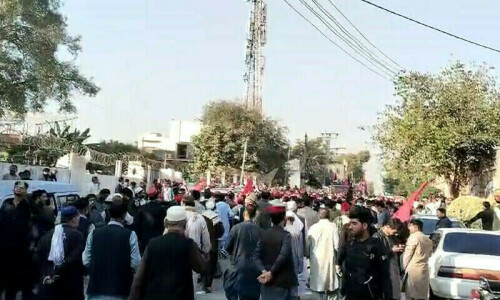HYDERABAD, May 2: Members of a committee constituted last year to handle emergencies during water crisis disagreed with the opinion of the Sindh irrigation department that release of the Manchhar Lake water into the River Indus was inevitable. After holding detailed discussions, they were of the view that embankments of the Manchhar Lake were quite safe even at 114RL as compared to the present 109RL level and there was no need to reduce the water level to 104RL which could cause loss of human lives.
The committee met at the DCO’s office here on Monday to determine what steps and precautionary measures were needed before release of water from the lake into the Indus.
DCO Mohammad Hussain Syed presided over the meeting.
He told the meeting that the Sindh government had constituted the committee on “emergency response action for solving the problem of driking water and health crisis” on permanent basis.
The committee was headed by District Nazim Dr Makhdoom Rafiquzzaman but now the DCO would lead it because Dr Rafiquzzaman was removed from the seat by the Sindh government after the division of the Hyderabad district. Nazims of City, Latifabad and Qasimabad talukas, Kotri Barrage chief engineer, Hyderabad Development Authority director general, Water and Sanitation Agency managing director, Hyderabad Civil Hospital medical superintendent, Environmental Protection Agency assistant director and representatives of the WHO and Unicef are members of the committee.
The DCO said water specialists/consultants and representatives from Unicef had also been invited to the meeting to decide steps to meet the water crisis which might emerge after release of the Manchhar water into the Indus.
He said the River Indus was not only a source of drinking water for residents of Hyderabad but also for people of Karachi and lower areas of the province.
The meeting recommended to the Sindh government to constitute a high-level committee, comprising water specialists, engineers and scientists, to re-examine the capacity of the Manchhar Lake and decide whether release of water from it was necessary or not at present.
However, the DCO said in case release of the Manchhar water into the Indus was inevitable, the irrigation department must maintain the WHO-prescribed standard of water at the Kotri Barrage, also recommended by the M. A. Kazi Institute of Chemistry, University of Sindh, in its analysis report of water samples taken from the Manchhar Lake, Aral Wah, Sehwan (Bago Thoro) and the Indus River on April 27.
According to the water analysis report of the institute, he said, minimum safe limits for dilution of the Manchhar water with the Indus must be at the ratio of 1:30 to keep the river water’s total dissolved salts ratio within 500mg/litre, the permissible range of the WHO, at the Kotri Barrage.
He further said the standard ratio of 1:30 must be monitored continuously by the irrigation department with representatives of stakeholder civil bodies’ professionals and consultants.
The meeting also decided to launch a campaign to educate people in adopting precautionary measures and to arrange all medical facilities at hospitals in advance on emergency basis to avoid any loss of life as experienced last year on account of water crisis.
Kotri Barrage chief engineer Manzoor Ahmad Shaikh, however, differed with views of the participants of the meeting and said reduction of the Manchhar Lake level from 109RL to 105RL was essential for protection of the lake embankments.














































Dear visitor, the comments section is undergoing an overhaul and will return soon.